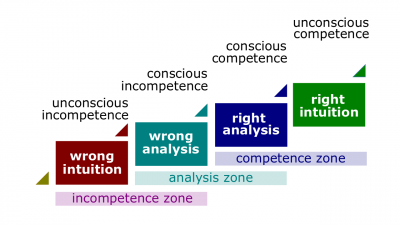Difference between revisions of "Structured-task competence"
(Created page with "400px|thumb|right|[[Hierarchy of competence]]Hierarchy of competence (alternatively known as competence learning model or four stages...") |
(→Related coursework) |
||
| Line 7: | Line 7: | ||
#[[Unconscious competence]] (or [[right intuition]]). A situation in which the individual not only understands and knows how to accomplish a [[task]], but has had so much practice with a skill that it has become "second nature" and can be performed easily. As a result, the skill can sometimes be performed while executing another [[task]]. The individual may be able to teach it to others, depending upon how and when it was learned. | #[[Unconscious competence]] (or [[right intuition]]). A situation in which the individual not only understands and knows how to accomplish a [[task]], but has had so much practice with a skill that it has become "second nature" and can be performed easily. As a result, the skill can sometimes be performed while executing another [[task]]. The individual may be able to teach it to others, depending upon how and when it was learned. | ||
| − | ==Related | + | ==Related lectures== |
*[[Individual Decisions Quarter]]. | *[[Individual Decisions Quarter]]. | ||
[[Category: Septem Artes Administrativi]][[Category: Articles]] | [[Category: Septem Artes Administrativi]][[Category: Articles]] | ||
Revision as of 15:05, 4 January 2019
Hierarchy of competence (alternatively known as competence learning model or four stages of competence; hereinafter, the Hierarchy) is a model that describes psychological states involved in the process of progressing from incompetence to analytical competence and, further, to intuitive competence in some knowledge, skill, and/or ability.
Stages
- Unconscious incompetence (or wrong intuition). A situation in which the individual neither understands nor knows how to accomplish a task and does not necessarily recognize the deficit.
- Conscious incompetence (or wrong analysis). A situation in which the individual neither understands or knows how to accomplish a task, but he or she recognizes the deficit. He or she also realizes the value of new knowledge, skill, and/or ability needed in addressing the deficit. The making of mistakes can be integral to the learning process at this level of competence.
- Conscious competence (or right analysis). A situation in which the individual understands and/or knows how to accomplish a task. However, demonstrating the knowledge, skill, and/or ability requires concentration. It may be broken down into steps, and there is heavy conscious involvement in executing the needed knowledge, skill, and/or ability.
- Unconscious competence (or right intuition). A situation in which the individual not only understands and knows how to accomplish a task, but has had so much practice with a skill that it has become "second nature" and can be performed easily. As a result, the skill can sometimes be performed while executing another task. The individual may be able to teach it to others, depending upon how and when it was learned.
